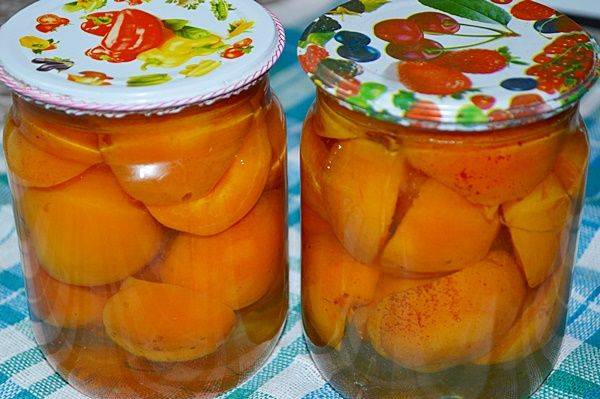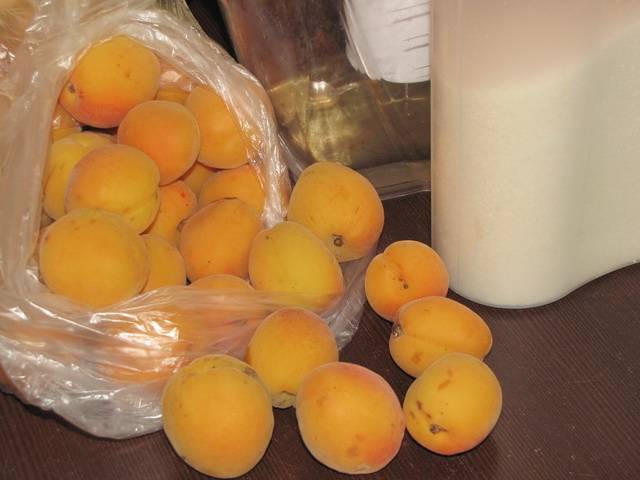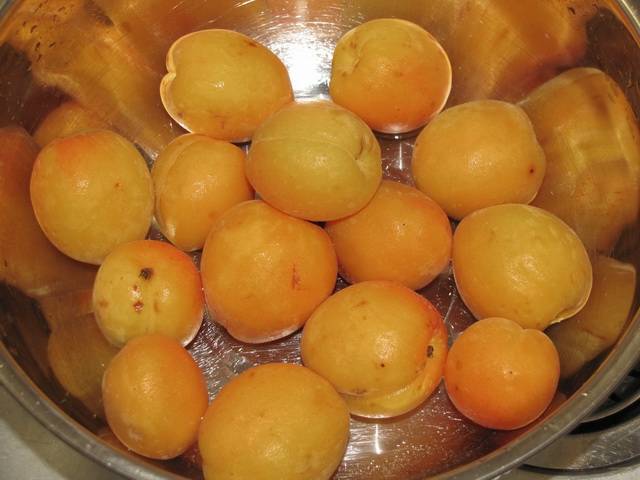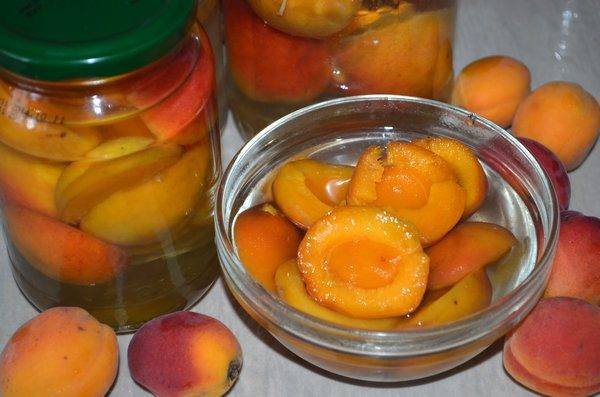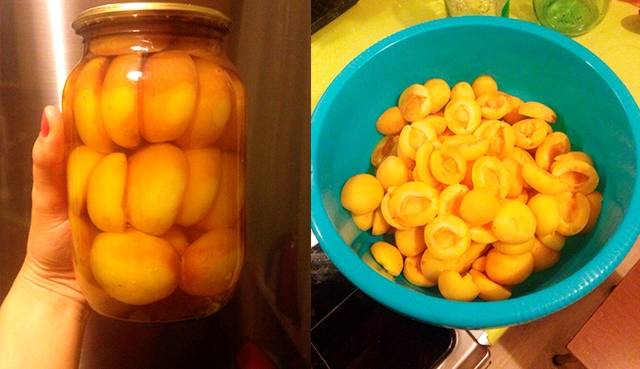Content
When a blizzard is sweeping outside the window and frosts creak, it is a fruit preparation made of apricots, reminiscent of little suns, that will help maintain good spirits and good mood, bringing with it a piece of summer sun warmth and light. There are a great many recipes for blanks from apricots, but in syrup they turn out to be as natural and tasty as possible, and in terms of ease of manufacture, they can hardly compete with any other delicacy.
How to make syrup
A syrup for preparing apricots is usually characterized by a rather high density and viscosity due to the significant sugar content. Although in some recipes especially for adherents of a healthy diet, the sugar content in the syrup is minimal.
So that the workpiece does not darken over time and does not become sugared, it is necessary to strictly observe the basic requirements for cooking syrup:
- To prepare the syrup, it is better to use a thick-walled saucepan or at least with a multi-layered bottom so that the sugar does not burn.
- The required amount of water according to the recipe is first brought to a boil and only then sugar is added to it.
- Sugar is added very gradually, in small portions and the syrup is constantly stirred thoroughly. The next portion of sugar must be added only after the previous portion is completely dissolved in water.
- After adding the last portion of sugar according to the recipe, the syrup is boiled for no more than 5 minutes.
Preparing fruits and dishes
Rinse apricots thoroughly. The best way to free the fruit from a variety of contaminants is to soak them for 15-20 minutes in cold water. After that, they must be well rinsed in running water and dried on a waffle or paper towel.
Glass jars for making canned food are also thoroughly washed, and then sterilized either in the oven, or in the microwave, or in the airfryer.
For preservation, it is enough to put the lids in boiling water for 30 seconds.
Apricot Syrup Recipes
Here are selected the most delicious, original and varied recipes for making apricots in syrup, so there are examples of blanks for almost every taste.
With bones
This recipe for harvesting apricots in syrup is considered the most traditional and at the same time the simplest and most affordable for execution, even for those housewives who decided to start preservation for the first time. For him, there is no need even for pre-cooking the sugar syrup, since the mixing of the products takes place already in the cans.
In addition, the workpiece with seeds turns out to be the richest in taste and aroma, and real gourmets will surely appreciate its merits.
Since 12 months after preparation apricot pits are able to begin to secrete poisonous hydrocyanic acid and the use of the workpiece can cause serious digestive problems.
For the preparation of the delicacy, fruits of medium ripeness are taken; they must be dense, not overripe. It is best to use medium and small apricots for this recipe, so that it is more convenient to place them in jars.
As for the size of the cans, it is more rational to use liter cans for this blank. However, for special receptions and meetings with many guests, you can also prepare several large 2 or 3 liter cans.
In addition to the actual apricots and sugar, it is necessary to boil several liters of water.
Cooked apricots are pierced in several places with a toothpick and tightly packed into sterilized jars. A glass of sugar is added to each liter jar on top. (In large jars, the amount of added sugar increases proportionally.)
Then each jar is filled with boiling water, leaving 1 cm to the brim, and covered with a lid. The next step is to sterilize the jars with the contents either in boiling water, or use any other convenient device for this: airfryer, microwave oven, oven. Liter cans are sterilized for 10 minutes.
At the end of the sterilization process, the jars are finally sealed and cooled at room temperature.
Slices
What is the beauty of this blank, that even greenish and not very sweet apricots can be used for it, the main thing is that they are firm and without damage. For many months of ripening in sweet syrup, they will in any case acquire the missing sweetness and juiciness.
The cooking method is also very simple.
First, the sugar syrup is cooked. To do this, 250 g of sugar and a small amount of citric acid (1/4 teaspoon) are dissolved in 400 ml of water. Boil for about 2-3 minutes to completely dissolve the sugar.
Simultaneously cooked apricots are cut into halves, or even into quarters, pits are removed from them, and they are tightly packed, cut down, into sterile jars. With boiling syrup, very carefully, the jars of fruit are poured, not reaching 1 cm to the neck.
Having covered the jars with sterile lids, they must be sterilized: 0.5 liter jars - 15 minutes, 1 liter jars - 20 minutes.
After sterilization, the jars are finally closed, turned over with the lids down and sent to cool at room temperature.
In honey syrup
For those who are trying to keep sugar consumption to a minimum and in all cases looking for a substitute for it, the following recipe is offered. Instead of sugar, honey is used, and the preparation immediately acquires a special taste and aroma. All manufacturing steps are similar to those described in the previous recipe, but when cooking syrup, 1 glass of honey is added to 2.5 cups of water. This amount of syrup should be enough to spin 1.5 kg of apricot.
Such a blank can be stored even in room conditions for more than one year - these are the preserving properties of honey. The main thing is that the apricots are completely dry, the ingress of even a drop of water into the workpiece can adversely affect its safety.
Without sterilization
Among those who do not like to mess with sterilization, the following recipe is very popular.
It is taken:
- 500-600 g of apricots;
- 300-400 g sugar;
- 400 ml of water.
This amount of ingredients is usually enough for one liter jar. The stacked apricots are poured with cooked sugar syrup and infused for about 20 minutes. Then the syrup is drained, heated again to a boil and again poured into the jar. This procedure must be repeated a total of three times. After that, the jars are twisted with lids and wrapped in an inverted state until they cool.
Without cooking
Especially tasty are apricots prepared according to a similar recipe, but with a large amount of sugar and a longer infusion period.
In this version, 1 kg of sugar and only 200 g of water are taken for 1 kg of apricots. After the first pouring of apricots with sugar syrup, they are infused for about 6-8 hours, then the syrup is drained, brought to a boil and the apricots are again poured into them. Again, 6-8 hours exposure follows, and these processes should be repeated 5-6 times in a row (or as long as there is patience).Of course, it will take a few days, but the result is worth the time. At the end, as usual, the jars are closed with lids and turned over until they cool completely.
If you want to do without heat treatment at all and at the same time completely preserve the taste of fresh apricots, then use the following recipe:
Prepare a syrup with 500 g of water and 200 g of sugar and cool it. Place the prepared apricots, cut in half, into a suitable freezer container and pour over the cooled syrup. Then close the container with a lid and place in the freezer. In this form, the preparation of apricots can be stored even longer than any preservation, and after thawing, the apricots will look like almost fresh fruit.
Conclusion
As you can see, apricots in syrup can be made for every taste, so any housewife should have such a preparation in the house.
